 American Herring Gull (smithsonianus)
American Herring Gull (smithsonianus)
(last update: October 30, 2015)
American Herring Gull adult January
The issue of Dutch Birding 26: 151-179, 2004 contained a very comprehensive paper on the identification of adult smithsonianus in a European context, titled: Identification of adult American Herring Gull. It was written by Peter Adriaens & Bruce Mactavish. The outstanding text is copied on this webpage, with links now added to various Canadian and European birds placed on the ORG-website. When appropriate, more details from recent field research has been added as well. Full PDF download: HERE.
Identification of adult American Herring Gull
-Peter Adriaens & Bruce Mactavish-
Recently, the identification of American Herring Gull Larus smithsonianus (hereafter smithsonianus) in a European context has been discussed in several papers, most thoroughly by Lonergan & Mullarney (2004). While these papers have greatly increased our knowledge of this taxon, they focused mostly on the identification of immature birds, Adults have always remained a bit of a mystery, since they seem almost identical to European Herring Gull L argentatus, particularly of the subspecies L a argenteus (hereafter argenteus). Some authors have hinted at possible differences in the primary pattern, including Garner & Millington (1998) and Oddie & Doherty (2000), but such characters were never studied in more detail. In addition, it has become apparent that there may be significant regional variation in smithsonianus, complicating the identification outside its normal range. While some variation between East and West Coast populations was already pointed out a long time ago by, eg, Dwight (1925), consistent differences between Newfoundland birds (‘Newfoundland American Herring Gull’, hereafter NF smithsonianus) and birds wintering in the Niagara region have been published recently by Jonsson & Mactavish (2001), indicating that there may be more than just two different populations. The most recent treatment of the subject of geographical variation is found in Olsen & Larsson (2003).
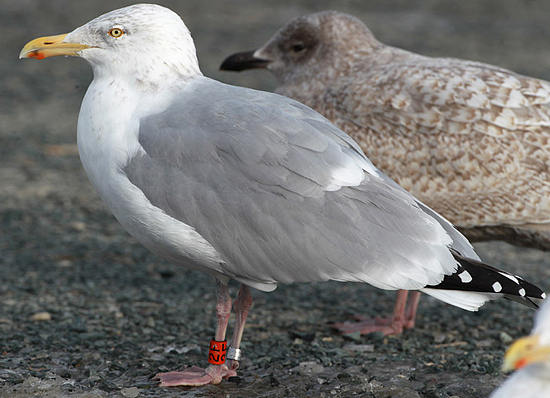
American Herring Gull L. smithsonianus, adult, St John's, Newfoundland,
Canada, 08 February 2006 (Bruce Mactavish). Note blackish spot near gonys.
In this paper, we discuss the possibilities of finding and identifying adult smithsonianus in Europe. We believe that a reliable identification will be possible in some cases, if strict criteria are met. We present a detailed analysis of all relevant characters and suggest combinations that we believe to be diagnostic. We also describe some of the regional variation that we have encountered in smithsonianus, although this should by no means be seen as a complete overview. We merely hope that it will stimulate further research in North America, Before discussing the identification criteria, we would like to emphasize two important points. Firstly, identification of adult smithsonianus in Europe will not be possible without good photographs and/or video sequences illustrating the primary pattern. This is of critical importance. Preferably, such images should have been taken from close up, and show the primaries both from above and below. As a rule, you can not observe all of the necessary details of the primary pattern in the field - unless it concerns a dead bird! Secondly, it should be noted that this paper has a strong European bias. It focuses exclusively on the identification of adult smithsonianus in a European context, and is not meant to be used the other way round. A large-scale research on regional variation in smithsonianus is necessary before one can attempt to identify argenteus in North America.
Material and methods
Our results are mainly based on the analysis of museum skins, dead birds, photographs and video sequences. In addition, we both have extensive field experience with smithsonianus and European Herring Gulls. Bruce Mactavish has seen adults of both species together (three adult argentatus among NF smithsonianus). Since we did not have the time nor means to examine smithsonianus from all parts of North America, we decided to focus on one single population that is likely to stray to Europe: the NF smithsonianus. There were several reasons for this choice:
1 Newfoundland is the easternmost part of North America, and is closest to Greenland. Birds from that region and adjoining parts of eastern Canada are likely to turn up in Europe from time to time. In fact, the first European record of smithsonianus concerned a bird that was ringed in a neighbouring part of Canada (New Brunswick) (Gross 1940);
2 Of all groups of smithsonianus we examined, the Newfoundland adults appear to be the most distinctive compared with European birds, particularly argenteus;
and 3 BM has been living in Newfoundland for years and is thoroughly familiar with the local smithsonianus, which are very common and easily studied.
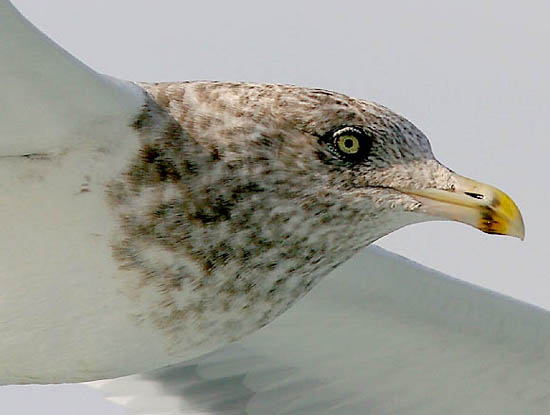
above: American Herring Gull L. smithsonianus, adult, Monterey Bay - California, USA, 14 November 2004 (Jeff Poklen).
below:
European Herring Gull L. argentatus, adults from Estonia, Estonia, Denmark & Russia.

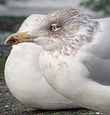

For this paper, the primary patterns of 208 adult NF smithsonianus were studied in detail on the basis of dead birds, photographs by BM and video sequences by Peter Adriaens. Outside Newfoundland, we have studied adult smithsonianus in Canada (Niagara and Toronto, Ontario, Northwest Territories and Yukon) and the USA (New York and New Jersey). Through museum curators, we also obtained many photographs of stretched wings from Canada (Alberta, British Columbia, Northwest Territories and Yukon) and the USA (Alaska, California, Connecticut, Maine, Maryland, Massachusetts, Michigan, New Jersey, New York, North Carolina, Virginia and Washington). Sample sizes are given later on in the paper.
On the European side, the primary patterns of 182 adult argenteus were studied, from dead birds, museum skins (from Belgium, England and Ireland), video sequences obtained in Belgian breeding colonies and photographs (from England, Iceland and the Netherlands). A total of 36 adult European Herring Gulls of the nominate subspecies L a argentatus (hereafter argentatus) were thoroughly studied, from museum skins from Denmark, video sequences obtained in Belgium (in winter), and photographs from England (winter) and Norway. Another 70 winter adults from Germany were examined (on photographs of captured birds) but were not included in the final results since their origin was unknown.
In addition, eight suspected adult hybrids argentatus x Pontic Gull L cachinnans were also examined, on basis of photographs from Poland.
One important point is that, when describing the variation in adult European Herring Gulls, we have chosen to consider two additional ’forms’, apart from argenteus and argentatus. This was the most convenient way to explain the regional variation and should definitely not be seen as any taxonomic suggestion from our pan! These additional forms are:
1 Intergrades argenteus >< argentatus. There is a zone of clinal variation between these subspecies, as indicated by measurements (cf Cramp & Simmons 1983) and morphological characters. Adults showing pale grey to medium grey upperparts and a primary pattern somewhere ’in between' (although in some the pattern may fit either subspecies) breed in the very north of the Netherlands, north-western Germany and south-western Denmark. Barth (1975) classified these birds still as argenteus but commented that ‘they form, to some degree, a mixed population with nominate argentatus’ in that region. In winter, intergrades are relatively common from at least Belgium to the west coast of Denmark (Klaus Malling Olsen pers comm; pers obs). Examples of what we believe to be such birds are shown in plate 242-244 (of PDF; but see also mVZ and oHE).
2 ’Eastern Baltic Herring Gull', This name refers to those argentatus breeding along the eastern Baltic Sea, eg, in Belarus, Estonia, Finland, Latvia and Poland. They quite often have yellow legs, the upperparts are slightly paler than in ’northern' or ’Arctic’ argentatus, the primary pattern is often also subtly different and the moult seems to occur slightly earlier, thus being more similar to argenteus (Hario & Kilpi 1986, Mierauskas & Greimas 1992, Jonsson 1998; pers obs; Klaus Malling Olsen pers comm). They mainly stay in the Baltic region in winter with dispersal to Kattegat and Skagerrak, but a few reach further south, as far as the Adriatic Sea and Lake Garda, Italy (Olsen & Larsson 2003). At least a few occur in Western Europe in winter too, as indicated by ringing recoveries. For this paper, 85 adult
Eastern Baltic Herring Gulls were studied, from video sequences taken in southern Finland and photographs from Belarus, Estonia, Latvia and Poland.
It should be taken into account that argentatus shows clinal variation too, showing darker grey upperparts and paler wing-tips towards northern Scandinavia.
Identification
There are two main problems to consider when it comes to identifying adult smithsonianus in
Europe:
1 How to detect a potential smithsonianus, especially in a flock of argenteus; and
2 how to arrive at a conclusive identification. The following sections refer exclusively to smithsonianus of the Newfoundland population but probably also apply to birds from surrounding parts of eastern Canada.
Finding a good candidate
Given the regular occurrence of immature smithsonianus in Europe (cf Lonergan & Mullarney 2004), adults are likely to occur as well. Indeed, there have already been several claims from the Azores, Britain and Ireland (cf here , here, here). While these reports could not (yet) be proven, they at least show that birders are aware of the possible occurrence. Although adult smithsonianus are perhaps most likely to turn up in countries such as Britain, Iceland, Ireland and Norway, they may be far easier to detect in, eg, Portugal and Spain, where European Herring Gulls are scarce. Especially the Azores are well-positioned; the islands Corvo and Flores are, in fact, closer to Newfoundland than to mainland Europe!
While some adult NF smithsonianus may stand out in size, structure and head streaking, this will not usually be the best way to look for them, as there is much overlap with European Herring Gulls in these respects.
Three characters that may be helpful, when used in combination
 Herring Gull L.a. argenteus J5, measurements of grey tone on adults. Herring Gull L.a. argenteus J5, measurements of grey tone on adults. |
UPPERPARTS First of all, it should be established that the upperparts are pale grey. Smithsonianus has an estimated Kodak grey-scale value of 4-4.5 (rarely 5.0; cf Howell & Elliott 2001), while in argenteus it is 5.0-5.5 (Jonsson 1998). Olsen & Larsson (2003) give
(3)3.5-6 for smithsonianus and 3-5.5 for argenteus. Newfoundland birds are among the palest of smithsonianus, probably having a Kodak grey-scale value of c (3)3.5-4.5 on average. Their upperparts are, in fact, quite similar to those of Ring-billed Gull L delawarensis, and nearly as pale as in Black-headed Gull L ridibundus (pers obs). In any case, an adult smithsonianus, and Newfoundland birds in particular, should not normally stand out as visibly darker in a flock of argenteus.
The mantle colour is most important with regard to argentatus and Eastern Baltic Herring Gull. The latter is said to have an average Kodak grey-scale value of 5.6, and argentatus of 5.0-7.0 (Jonsson 1998); Olsen & Larsson (2003) give (4)4.5-6 and (4)5-7(8), respectively.
Variation in mantle shade of argentatus is clinal, ranging from palest in Danish birds (which overlap with argenteus in this respect) to darkest in Arctic regions. Keep in mind, however, that bright sunlight may make it more difficult to assess mantle shades correctly, and that the shade of the upperparts often seems to vary with the position of the bird. Prolonged field observation may be necessary.
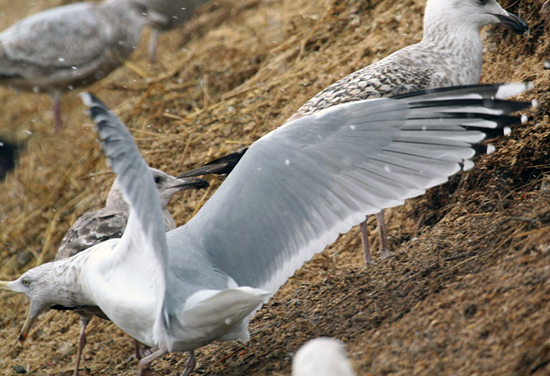
above: American Herring Gull L. smithsonianus, adult, Dryden, NY, USA. 10 February 2008 (Mike).
UNDERSIDE OF WING-TIP A good character to look for, is the underside of the wing-tip at rest. In NF smithsonianus, the grey tongue on the outermost primary (P10) is often long (ie, covering more than half of the length of the inner web), broad, and very steeply (c 90°) curved at the end (see figure 5a, and plate 224-229). Such a tongue is actually quite similar to that of adult Pontic Gull. It is often visible at rest, if you look at the underside of the far wing-tip. This pattern was found in 69% of our sample of Newfoundland birds. In many birds, the remaining black ’medial band' (ie, the black separation between tongue and mirror) is smaller than the white mirror. In argenteus, the grey tongue on P10 is normally short (less than half the length of the innerweb), and pointed, oblique, or wedge-shaped (figure 5c) (in more than 95%). It is therefore not visible at rest; the underside of the wing-tip looks all-black, except for the white mirror. Occasionally, birds with a longer grey tongue occur (less than 2%), but the combination of a long (> 1/2) grey tongue and very steeply curved shape was not found in our sample of argenteus. However, such a combination is occasionally seen in intergrades, pure argentatus, Eastern Baltic Herring Gull, and hybrids argentatus x cachinnans. It will usually be possible to eliminate most of these on the basis of mantle colour but some birds of any of these forms appear just as pale as pure argenteus, so it may be necessary to check more characters, however subtle, before investing a lot of time in a particular bird. In this respect, it may be interesting to combine the length and shape of the tongue with the presence of black marks near the tip of this primary. Most European Herring Gulls that show a long, ‘cachinnans-like' tongue here, often have an all-white mirror and tip without any subterminal black markings, which is only infrequently the case in NF smithsonianus. Keep in mind, however, that if you look at the underside of the wing-tip on a resting bird, the black subterminal band of P9 may often ’shimmer through’ and create the illusion of black marks near the tip of P10 (cf figure 11, and compare with plate 224). Careful observation is needed, preferably from up close. The combined characters of P10 will be discussed in more detail later on in this paper.
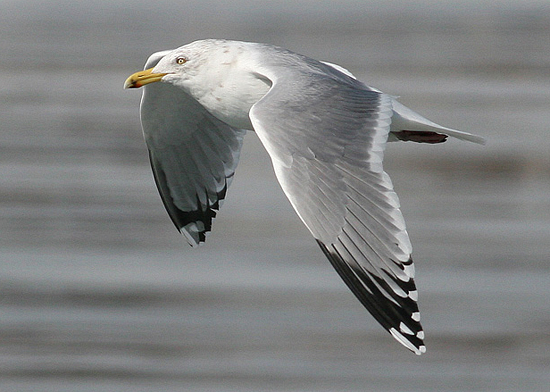
above: American Herring Gull L. smithsonianus, adult, Bluff-Point State Park, Connecticut, USA. 20 February 2007 (Mats Wallin).
PATTERN OF P5 If the bird is preening its wings, the pattern of P5 (the last primary to be covered by the tertials at rest) is worth noting: many NF smithsonianus have a complete black band, which is often shaped like a distinct ’W’ (see next section ’How to be sure? for more details; see also figure 10a, and plate 225, 226, 228 and 230). The combination of a long, almost rectangular tongue on P10 and a complete ’W’ on P5 is quite significant (again, see next section). Those NF smithsonianus that have only an incomplete black band on P5 often still show a forked (or 'U’-shaped) pattern on the outer web (figure 10b). The primary pattern will be dealt with in much more detail later on in this paper.
East coast birds
 American Herring Gull (smithsonianus) adult AAF June & October 2011 & January 2012. Picture: Ingrid Pollet.
American Herring Gull (smithsonianus) adult AAF June & October 2011 & January 2012. Picture: Ingrid Pollet. American Herring Gull (smithsonianus) C47 10CY & 12CY, January 2014 & December 2016, Brooklyn, NY. Picture: Sean Sime & Andrew Baksh.
American Herring Gull (smithsonianus) C47 10CY & 12CY, January 2014 & December 2016, Brooklyn, NY. Picture: Sean Sime & Andrew Baksh. American Herring Gull (smithsonianus) adult C71 2009 & 2011, Salisbury State Reservation, Massachusetts. Picture: Suzanne Sullivan & Jonathan Mays.
American Herring Gull (smithsonianus) adult C71 2009 & 2011, Salisbury State Reservation, Massachusetts. Picture: Suzanne Sullivan & Jonathan Mays. American Herring Gull (smithsonianus) 5cy & 7cy E81 November 2010 & January 2012, Newcastle Commons, NH. Picture: Lauren Kras.
American Herring Gull (smithsonianus) 5cy & 7cy E81 November 2010 & January 2012, Newcastle Commons, NH. Picture: Lauren Kras. American Herring Gull (smithsonianus) H99 4CY & 7CY, August 2010 & January 2013, NH. Picture: Jon Worthen & Lauren Kras.
American Herring Gull (smithsonianus) H99 4CY & 7CY, August 2010 & January 2013, NH. Picture: Jon Worthen & Lauren Kras. American Herring Gull (smithsonianus) M43 adult, January 26 2014, Hampton Harbor, NH. Picture: Nathan Purmort.
American Herring Gull (smithsonianus) M43 adult, January 26 2014, Hampton Harbor, NH. Picture: Nathan Purmort. American Herring Gull (smithsonianus) M71 adult, January 05-12 2013, Salisbury, MA. Picture: J. Trimble & Suzanne Sullivan.
American Herring Gull (smithsonianus) M71 adult, January 05-12 2013, Salisbury, MA. Picture: J. Trimble & Suzanne Sullivan.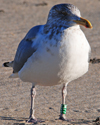 American Herring Gull (smithsonianus) adult M77 January 26 2013, Hampton Beach, NH. Picture: Jon Worthen.
American Herring Gull (smithsonianus) adult M77 January 26 2013, Hampton Beach, NH. Picture: Jon Worthen. American Herring Gull (smithsonianus) U03 adult, July 2015 & January 2016, New Hampshire & Brooklyn. Picture: Amar Ayyash & Klemens Gasser.
American Herring Gull (smithsonianus) U03 adult, July 2015 & January 2016, New Hampshire & Brooklyn. Picture: Amar Ayyash & Klemens Gasser.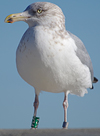 American Herring Gull (smithsonianus) V34 August 24 2013 & January 11 2016, Jenness Beach, Rye & Hampton, NH. Picture: Lauren Kras, Robbie & Colleen Prieto.
American Herring Gull (smithsonianus) V34 August 24 2013 & January 11 2016, Jenness Beach, Rye & Hampton, NH. Picture: Lauren Kras, Robbie & Colleen Prieto. American Herring Gull (smithsonianus) V72 5th-6th cycle (6CY-7CY), January 2017 & 2018, Salisbury Beach State Park - Salisbury MA. Picture: Dave Adrien & Dan Prima.
American Herring Gull (smithsonianus) V72 5th-6th cycle (6CY-7CY), January 2017 & 2018, Salisbury Beach State Park - Salisbury MA. Picture: Dave Adrien & Dan Prima. American Herring Gull (smithsonianus) AG03 adult, January 09 2015, Rochester WWTP - Rochester, NH. Picture: Jason Lambert.
American Herring Gull (smithsonianus) AG03 adult, January 09 2015, Rochester WWTP - Rochester, NH. Picture: Jason Lambert.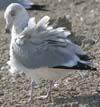 American Herring Gull (smithsonianus) 4th cycle (5CY) 0886-75788 January 26 2005, Corpus Christi, TX. Picture: Martin Reid.
American Herring Gull (smithsonianus) 4th cycle (5CY) 0886-75788 January 26 2005, Corpus Christi, TX. Picture: Martin Reid.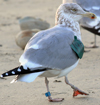 American Herring Gull (smithsonianus) adult 196 / 11 January 01 2014, Salisbury state beach, Massachusetts. Picture: Knut Hansen.
American Herring Gull (smithsonianus) adult 196 / 11 January 01 2014, Salisbury state beach, Massachusetts. Picture: Knut Hansen. American Herring Gull (smithsonianus) adult, January 22 2012, Kettle Cove - Portland, Maine. Picture: Bill Bunn.
American Herring Gull (smithsonianus) adult, January 22 2012, Kettle Cove - Portland, Maine. Picture: Bill Bunn. American Herring Gull (smithsonianus) adult, January 18 2010, Ocean City inlet, Worcester Co., MD. Picture: Frode Jacobsen.
American Herring Gull (smithsonianus) adult, January 18 2010, Ocean City inlet, Worcester Co., MD. Picture: Frode Jacobsen. American Herring Gull (smithsonianus) adult, January 18 2015, West Pubnico, Nova Scotia. Picture: Ronnie Dentremont.
American Herring Gull (smithsonianus) adult, January 18 2015, West Pubnico, Nova Scotia. Picture: Ronnie Dentremont. American Herring Gull (smithsonianus) adult, January 04 2015, Bronte Harbour, Oakville, Ontario. Picture: Gavin Edmondstone.
American Herring Gull (smithsonianus) adult, January 04 2015, Bronte Harbour, Oakville, Ontario. Picture: Gavin Edmondstone. American Herring Gull (smithsonianus) adult, January 01 2013, St. John's, Newfoundland, Canada. Picture: Lee Hoy.
American Herring Gull (smithsonianus) adult, January 01 2013, St. John's, Newfoundland, Canada. Picture: Lee Hoy. American Herring Gull (smithsonianus) adult, January 08 2013, Searsport, Maine, USA. Picture: Jim McCree.
American Herring Gull (smithsonianus) adult, January 08 2013, Searsport, Maine, USA. Picture: Jim McCree. American Herring Gull (smithsonianus) adult, January 27 2008, Dryden, NY, USA. Picture: Mike.
American Herring Gull (smithsonianus) adult, January 27 2008, Dryden, NY, USA. Picture: Mike. American Herring Gull (smithsonianus) adult, January 19 2013, Worcester Co., MD. Picture: Frode Jacobsen.
American Herring Gull (smithsonianus) adult, January 19 2013, Worcester Co., MD. Picture: Frode Jacobsen.South coast
 American Herring Gull (smithsonianus) adult, January 03 2009, Coast Gulf - Texas, USA.
American Herring Gull (smithsonianus) adult, January 03 2009, Coast Gulf - Texas, USA. American Herring Gull (smithsonianus) adult, January 04 2009, Coast Gulf - Texas, USA.
American Herring Gull (smithsonianus) adult, January 04 2009, Coast Gulf - Texas, USA.Great Lakes
 American Herring Gull (smithsonianus) adult, January 03 2012, Seattle WA, USA. Picture: Amar Ayyash.
American Herring Gull (smithsonianus) adult, January 03 2012, Seattle WA, USA. Picture: Amar Ayyash.
 American Herring Gull (smithsonianus) adult, January 03 2012, Seattle WA, USA. Picture: Amar Ayyash.
American Herring Gull (smithsonianus) adult, January 03 2012, Seattle WA, USA. Picture: Amar Ayyash.
 American Herring Gull (smithsonianus) adult, January 28 2012, Calumet Park, Chicago, IL, USA. Picture: John Kendall.
American Herring Gull (smithsonianus) adult, January 28 2012, Calumet Park, Chicago, IL, USA. Picture: John Kendall.







